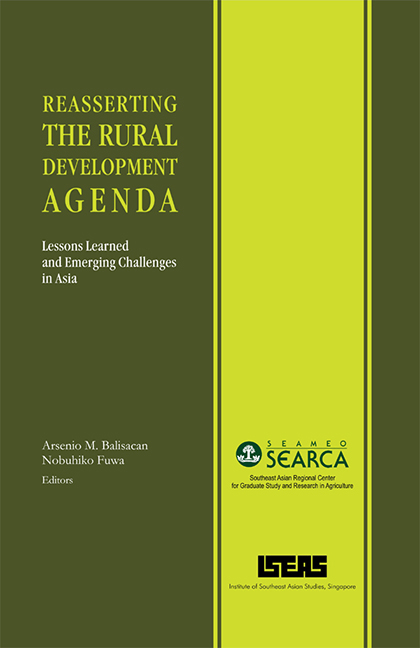Book contents
- Frontmatter
- Contents
- Tables
- Figures
- Preface
- Contributors
- 1 Challenges and Policy Options for Agricultural Development – Overview and Synthesis
- 2 The Economics of Agricultural Development: What Have We Learned?
- 3 The Role of Social Structures and Norms in Agricultural Development: Africa and East Asian Communities Compared
- 4 Food Security in a Globalised Setting
- 5 Poverty and Vulnerability
- 6 Asian Agricultural Development: From the Green Revolution to the Gene Revolution
- 7 Dryland Agriculture in Asia: Ideas, Paradigms, and Policies
- 8 Establishing Efficient Use of Water Resources in Asia
- 9 Improving the Delivery of Extension Services to Rural People: New Perspectives
- 10 Land Tenure and Forest Resource Management in Asia
- 11 Globalisation and the Poverty-Environment Link in Asian Agriculture
- 12 The Supermarket Revolution with Asian Characteristics
- Index
6 - Asian Agricultural Development: From the Green Revolution to the Gene Revolution
Published online by Cambridge University Press: 21 October 2015
- Frontmatter
- Contents
- Tables
- Figures
- Preface
- Contributors
- 1 Challenges and Policy Options for Agricultural Development – Overview and Synthesis
- 2 The Economics of Agricultural Development: What Have We Learned?
- 3 The Role of Social Structures and Norms in Agricultural Development: Africa and East Asian Communities Compared
- 4 Food Security in a Globalised Setting
- 5 Poverty and Vulnerability
- 6 Asian Agricultural Development: From the Green Revolution to the Gene Revolution
- 7 Dryland Agriculture in Asia: Ideas, Paradigms, and Policies
- 8 Establishing Efficient Use of Water Resources in Asia
- 9 Improving the Delivery of Extension Services to Rural People: New Perspectives
- 10 Land Tenure and Forest Resource Management in Asia
- 11 Globalisation and the Poverty-Environment Link in Asian Agriculture
- 12 The Supermarket Revolution with Asian Characteristics
- Index
Summary
Introduction
The past four decades have seen two waves of agricultural technology development and diffusion to developing countries, and Asian countries have been at the forefront of both. The first wave was initiated by the Green Revolution in which improved germplasm was made available to developing countries as a public good through an explicit strategy for technology development and diffusion. The second wave, which is currently underway, is being generated by the Gene Revolution in which a global and largely private agricultural research system is creating improved agricultural technologies that are flowing to developing countries primarily through market transactions. While some Asian countries are leading the Gene Revolution in agriculture, many lack the research and regulatory capacity to participate fully, and their underdeveloped markets for agricultural inputs and outputs weaken the incentives for technology development and adoption. These institutional requirements make it unclear whether the Gene Revolution can generate widespread benefits for poor farmers in poor countries.
The Green Revolution was responsible for an extraordinary period of growth in food crop productivity in the developing world. Productivity growth has been significant for rice in Asia, wheat in irrigated and favourable production environments worldwide, and maize in Mesoamerica and selected parts of Africa and Asia. A combination of high rates of investment in crop research, infrastructure and market development, as well as appropriate policy support, fuelled this productivity growth. These elements of the Green Revolution strategy improved productivity growth despite the increasing land scarcity and high land values (Pingali and Heisey 2001).
The Green Revolution transformed global food production systems and, in the process, defied the conventional wisdom that agricultural technology does not travel well because it is either agro-climatically specific, as with biological technology (i.e., seeds), or sensitive to relative factor prices, as with mechanical technology (Byerlee and Traxler 2002). The Green Revolution strategy for food crop productivity growth was explicitly based on the premise that, given appropriate institutional mechanisms, technology spillovers across political and agro-climatic boundaries could be captured. Efforts to develop the necessary institutional capacity, particularly in plant breeding, were a central part of the Green Revolution strategy.
- Type
- Chapter
- Information
- Reasserting the Rural Development AgendaLessons Learned and Emerging Challenges in Asia, pp. 159 - 190Publisher: ISEAS–Yusof Ishak InstitutePrint publication year: 2007



